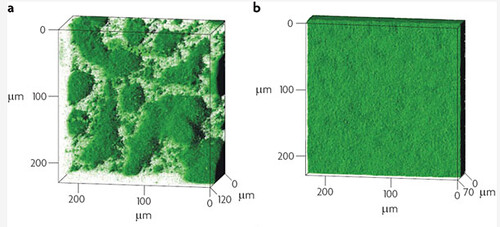Team:Glasgow/Biofilm/P. aeruginosa
From 2011.igem.org
| Line 8: | Line 8: | ||
<i>Pseudomonas aeruginosa </i> is the standard organism for the investigation of biofilms, as it is very adept at forming them. This ability is mainly due to the production of exopolysaccharides (EPS), most notably the protein alginate, that is produced by the mucoid strains of <i>P. aeruginosa</i> such as SG81 and leads to the production of notably thicker and more stable biofilms,though it is not essential for biofilm formation</p> | <i>Pseudomonas aeruginosa </i> is the standard organism for the investigation of biofilms, as it is very adept at forming them. This ability is mainly due to the production of exopolysaccharides (EPS), most notably the protein alginate, that is produced by the mucoid strains of <i>P. aeruginosa</i> such as SG81 and leads to the production of notably thicker and more stable biofilms,though it is not essential for biofilm formation</p> | ||
<div><img src="http://farm7.static.flickr.com/6179/6170658008_ee5d0dab3b.jpg"><p><font size="1" color="grey">Biofilm architecture in muciod and non-mucoid P.aeruginosa strains. a) Typical biofilm architecture of the mucoid (alginate over-expressing) SG81 strain b)The smoother biofilm architecture typical of non-mucoid strains such as the wild type PA01 that was used in this project </font></p></div></br> | <div><img src="http://farm7.static.flickr.com/6179/6170658008_ee5d0dab3b.jpg"><p><font size="1" color="grey">Biofilm architecture in muciod and non-mucoid P.aeruginosa strains. a) Typical biofilm architecture of the mucoid (alginate over-expressing) SG81 strain b)The smoother biofilm architecture typical of non-mucoid strains such as the wild type PA01 that was used in this project </font></p></div></br> | ||
| - | <p>The strain that was chosen for this project | + | <Another essential component of <i>P.aeruginosa</a> biofilm is eDNA (extracellular DNA), which functions as an intercellular connector by forming a grid-like structure. It has been shown that these biofilms can be disrupted by DNase.</p> |
| + | <p>The strain that was chosen for this project is the wild type PA01 strain, that forms stable smooth, and more homogenous biofilms.</p> | ||
Go back to<a href="https://2011.igem.org/Team:Glasgow/Biofilm"> Biofilms</a> | Go back to<a href="https://2011.igem.org/Team:Glasgow/Biofilm"> Biofilms</a> | ||
</html> | </html> | ||
Revision as of 22:03, 21 September 2011

Pseudomonas aeruginosa
Pseudomonas aeruginosa is the standard organism for the investigation of biofilms, as it is very adept at forming them. This ability is mainly due to the production of exopolysaccharides (EPS), most notably the protein alginate, that is produced by the mucoid strains of P. aeruginosa such as SG81 and leads to the production of notably thicker and more stable biofilms,though it is not essential for biofilm formation

Biofilm architecture in muciod and non-mucoid P.aeruginosa strains. a) Typical biofilm architecture of the mucoid (alginate over-expressing) SG81 strain b)The smoother biofilm architecture typical of non-mucoid strains such as the wild type PA01 that was used in this project
The strain that was chosen for this project is the wild type PA01 strain, that forms stable smooth, and more homogenous biofilms.
Go back to Biofilms "
"
